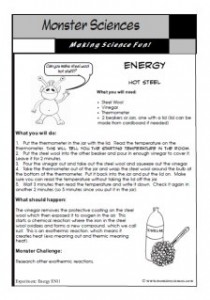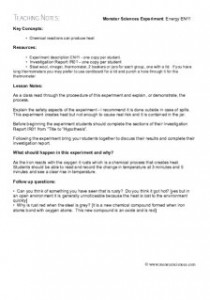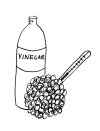Use simple steel wool and vinegar to make it hot! An amazing energy science experiment.
 |
 |
An experiment about energy: Hot steel
What you will need:
- Steel Wool
- Vinegar
- Thermometer
- 2 beakers or jars, one with a lid (lid can be made from cardboard if needed)
What you will do:
- Put the thermometer in the jar with the lid. Read the temperature on the thermometer. This will tell you the starting temperature in the room.
- Put the steel wool into the other beaker and pour in enough vinegar to cover it. Leave it for 2 minutes.
- Pour the vinegar out and take out the steel wool and squeeze out the vinegar.
- Take the thermometer out of the jar and wrap the steel wool around the bulb at the bottom of the thermometer. Put it back into the jar and put the lid on. Make sure you can read the temperature without taking the lid off the jar.
- Wait 3 minutes then read the temperature and write it down. Check it again in another 2 minutes (so 5 minutes since you put it in the jar).
What should happen:
The vinegar removes the protective coating on the steel wool which then exposed it to oxygen in the air. This starts a chemical reaction where the iron in the steel wool oxidizes and forms a new compound, which we call rust. This is an exothermic reaction, which means it creates heat (exo meaning out and thermic meaning heat).
Monster Challenge:
Research other exothermic reactions.
Teaching Notes: Monster Sciences Experiment: Energy EN11
Key Concepts:
Chemical reactions can produce heat
Resources:
• Experiment description EN11 – one copy per student.
• Investigation Report IR01 – one copy per student
• Steel wool, vinegar, thermometer, 2 beakers or jars for each group, one with a lid. If you have long thermometers you may prefer to use cardboard for a lid and punch a hole through it for the thermometer
Lesson Notes:
As a class read through the proceedure of this experiment and explain, or demonstrate, the process.
Explain the safety aspects of the experiment – I recommend it is done outside in case of spills. This experiment creates heat but not enough to cause real risk and it is contained in the jar.
Before beginning the experiment students should complete the sections of their Investigation Report IR01 from ”Title to “Hypothesis”.
Following the experiment bring your students together to discuss their results and complete their investigation report.
What should happen in this experiment and why?
As the iron reacts with the oxygen it rusts which is a chemical process that creates heat. Students should be able to read and record the change in temperature at 3 minutes and 5 minutes and see a clear rise in temperature.
Follow up questions:
- Can you think of something you have seen that is rusty? Do you think it got hot? [yes but in an open environment it is generally unnoticeable because the heat is lost to the environment quickly]
- Why is rust red when the steel is grey? [it is a new chemical compound formed when iron atoms bond with oxygen atoms. This new compound is an oxide and is red]



